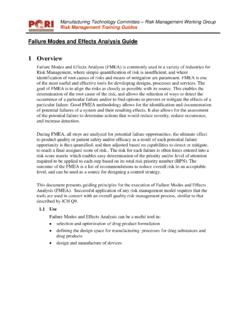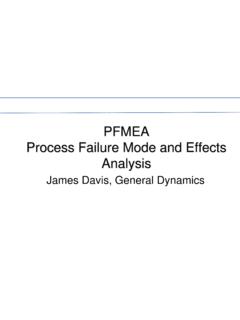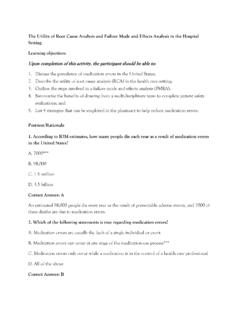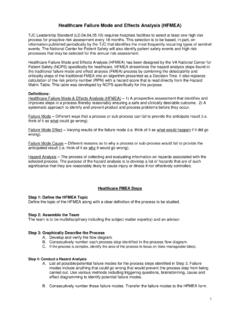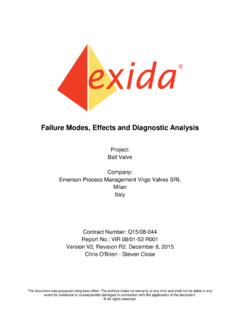Transcription of Failure Mode and Effects Analysis (FMEA) - …
1 Failure Mode and Effects Analysis (FMEA). UNDERSTANDING. THE FUNDAMENTAL. DEFINITIONS AND. CONCEPTS OF FMEAS. Material for this presentation is based on the book Effective FMEAs, by Carl S. Carlson, published by John Wiley & Sons, 2012. Definition of FMEA. Failure Mode and Effects Analysis (FMEA) is a method designed to: Identify and fully understand potential Failure modes and their causes, and the Effects of Failure on the system or end users, for a given product or process. Assess the risk associated with the identified Failure modes, Effects and causes, and prioritize issues for corrective action. Identify and carry out corrective actions to address the most serious concerns.
2 What is FMEA? An FMEA is an engineering Analysis done by a cross-functional team of subject matter experts that thoroughly analyzes product designs or manufacturing processes early in the product development process. Finds and corrects weaknesses before the product gets into the hands of the customer. What is FMEA? An FMEA should be the guide to the development of a complete set of actions that will reduce risk associated with the system, subsystem, and component or manufacturing/assembly process to an acceptable level. What is FMEA? Performing an FMEA just to fill a checkbox in the Product Development Process and then filing it away, never to be seen again, is a waste of time and adds no value.
3 If not for use as guidance through the development process, why waste the time and resources to do it in the first place? If effectively used throughout the product life cycle, it will result in significant improvements to reliability, safety, quality, delivery, and cost. Primary Objective of FMEA. The primary objective of an FMEA is to improve the design. For System FMEAs, the objective is to improve the design of the system. For Design FMEAs, the objective is to improve the design of the subsystem or component. For Process FMEAs, the objective is to improve the design of the manufacturing process. Primary Objective of FMEA. There are many other objectives for doing FMEAs, such as: identify and prevent safety hazards minimize loss of product performance or performance degradation improve test and verification plans (in the case of System or Design FMEAs).
4 Improve Process Control Plans (in the case of Process FMEAs). consider changes to the product design or manufacturing process identify significant product or process characteristics develop Preventive Maintenance plans for in-service machinery and equipment develop online diagnostic techniques Types of FMEAs The three most common types of FMEAs are: System FMEA. Design FMEA. Process FMEA. System FMEA. Analysis is at highest-level Analysis of an entire system, made up of various subsystems. The focus is on system-related deficiencies, including system safety and system integration interfaces between subsystems or with other systems interactions between subsystems or with the surrounding environment single-point failures (where a single component Failure can result in complete Failure of the entire system).
5 System FMEA. The focus (continued). functions and relationships that are unique to the system as a whole ( , do not exist at lower levels) and could cause the overall system not to work as intended human interactions service Some practitioners separate out human interaction and service into their own respective FMEAs. Design FMEA. Analysis is at the subsystem level (made up of various components) or component level. The Focus is on product design-related deficiencies, with emphasis on improving the design ensuring product operation is safe and reliable during the useful life of the equipment. interfaces between adjacent components. Design FMEA usually assumes the product will be manufactured according to specifications.
6 Process FMEA. Analysis is at the manufacturing/assembly process level. The Focus is on manufacturing related deficiencies, with emphasis on Improving the manufacturing process ensuring the product is built to design requirements in a safe manner, with minimal downtime, scrap and rework. manufacturing and assembly operations, shipping, incoming parts, transporting of materials, storage, conveyors, tool maintenance, and labeling. Process FMEAs most often assume the design is sound FMEA Definitions and Examples Generic FMEA Worksheet Responsible Actions Revised Potential Person Taken Rankings Occurrence Current Current Detection Potential Potential Severity effect (s) Design Design Recommended RPN.
7 Occurrence Item Function Failure Cause(s). Detection Target Effective Severity of Controls Controls Action(s). Mode of Failure RPN. Failure (Prevention) (Detection) Completion Completion Date Date 1 2 3 4 5 6 7 8 8 9 10 11 12. Item 1. An item is the focus of the FMEA project. For a System FMEA this is the system itself. For a Design FMEA, this is the subsystem or component under Analysis . For a Process FMEA, this is usually one of the specific steps of the manufacturing or assembly process under Analysis , as represented by an operation description. Example: Bicycle hand brake subsystem This illustration is from the book Effective FMEAs, by Carl S.
8 Carlson, published by John Wiley & Sons, 2012. Function 2. A function is what the item or process is intended to do, usually to a given standard of performance or requirement. For Design FMEAs, this is the primary purpose or design intent of the item. For Process FMEAs, this is the primary purpose of the manufacturing or assembly operation. Functions are typically described in a verb-noun format. There can be many functions for each item or operation. Example: Provides the correct level of friction between brake pad assembly and wheel rim to safely stop bicycle in the required distance, under all operating conditions. This illustration is from the book Effective FMEAs, by Carl S.
9 Carlson, published by John Wiley & Sons, 2012. Failure Mode 3. The term Failure mode combines two words that both have unique meanings. The Concise Oxford English Dictionary defines the word Failure as the act of ceasing to function or the state of not functioning. Mode is defined as a way in which something occurs Failure Mode 3. A Failure mode is the manner in which the item or operation potentially fails to meet or deliver the intended function and associated requirements. may include Failure to perform a function within defined limits inadequate or poor performance of the function intermittent performance of a function and/or performing an unintended or undesired function Example: Insufficient friction delivered by hand brake subsystem between brake pads and wheels during heavy rain conditions.
10 This illustration is from the book Effective FMEAs, by Carl S. Carlson, published by John Wiley & Sons, 2012. effect 4. An effect is the consequence of the Failure on the system or end user. This can be a single description of the effect on the top- level system and/or end user, or three levels of Effects (local, next-higher level, and end effect ). For Process FMEAs, consider the effect at the manuf. or assembly level, as well as at the system or end user. There can be more than one effect for each Failure mode. However, typically the FMEA team will use the most serious of the end Effects for the Analysis . Example: Bicycle wheel does not slow down when the brake lever is pulled potentially resulting in accident.
